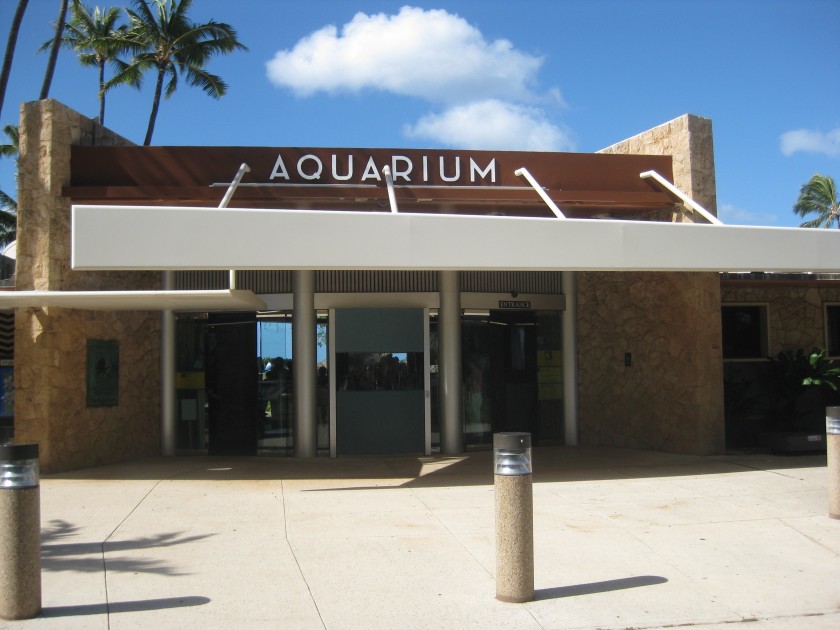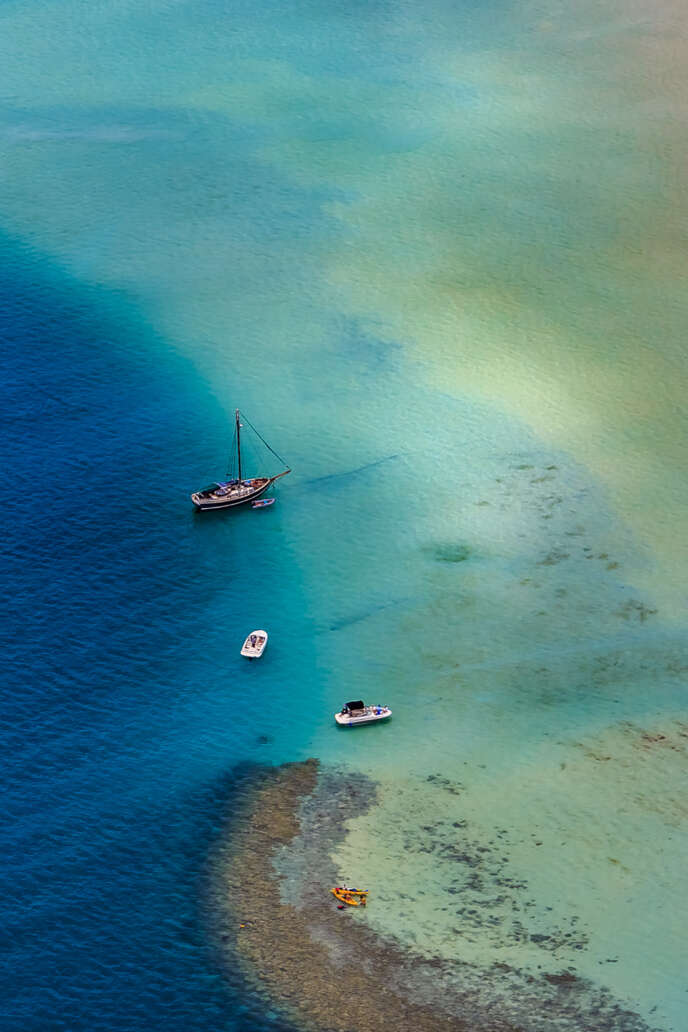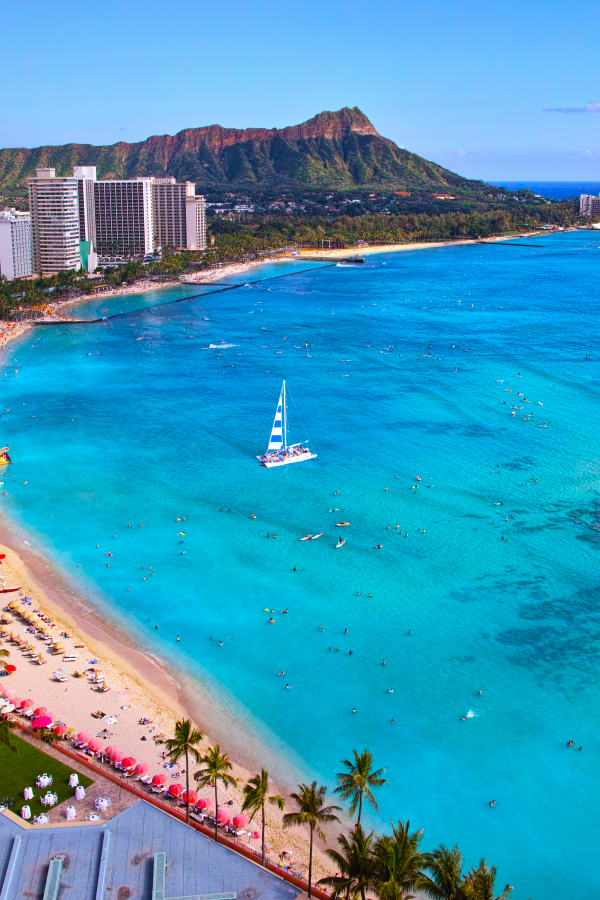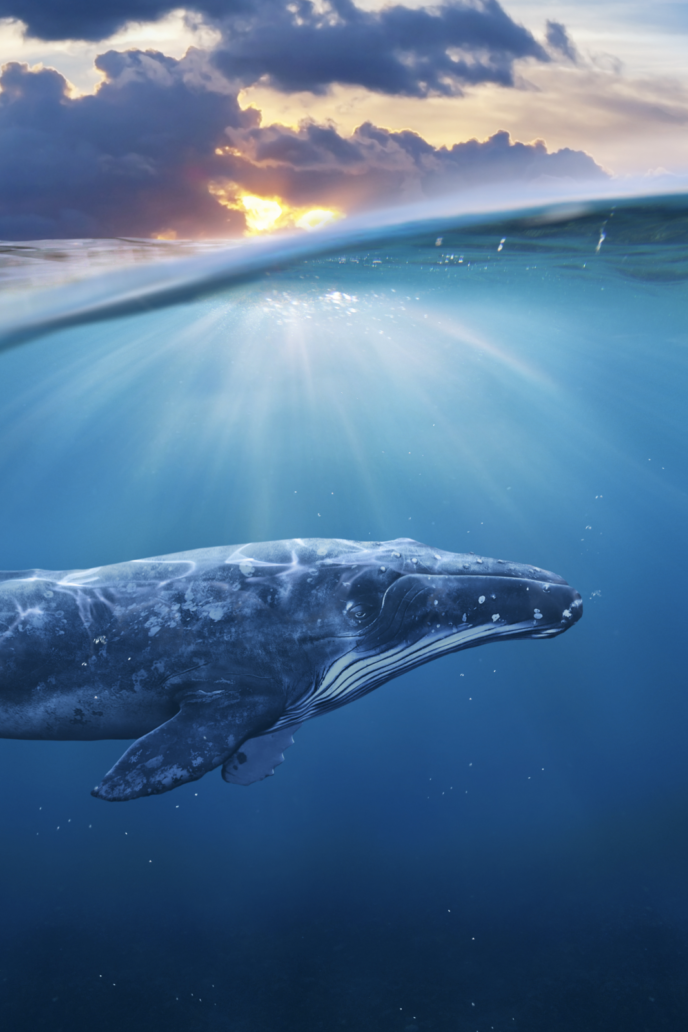Featured image © Meowmeow10, CC BY-SA 3.0, via Wikimedia Commons
Get up close and personal with exotic aquatic species from around the world at Honolulu’s Waikiki Aquarium! This waterfront attraction is a must-visit for anyone looking to experience the wonders of aquatic life. With over 3,500 animals from 500 species displayed in an 8-acre facility, you’ll be surrounded by the best of the undersea world. Plus, the aquarium offers exciting and educational programs on topics like marine life conservation and oceanic research. Whether you’re planning a family outing or a solo journey of discovery, Waikiki Aquarium has everything you need to make a serious splash!
Highlights
- Waikiki Aquarium is home to over 3,500 marine animals and 500 different species
- Have an opportunity to observe and interact with some of the ocean’s most fascinating creatures
- Get up close and personal with its inhabitants with numerous interactive exhibits
- It offers marine educational programs for adults and children alike
- Waikiki Aquarium works diligently towards protecting Hawaii’s delicate aquatic ecosystems through various conservation efforts
History
The Waikiki Aquarium is the second oldest aquarium in the United States, having first opened its doors to the public on March 19th, 1904. It was created by the Honolulu Rapid Transit and Land Company to showcase the island’s mesmerizing reef life and entice trolley riders. Despite the lack of formal training in marine science, Frederick A. Potter, the first director of the aquarium, was a passionate advocate for Hawaiian ichthyology. A donation from the C.M. Cooke Estate in 1912 paved the way for a marine biology laboratory, establishing the aquarium’s research tradition. Since then, the Waikiki Aquarium has undergone several transformations under the leadership of visionary directors. In 1975, Dr. Leighton Taylor reimagined the aquarium, putting education, conservation, and research at the forefront. Dr. Bruce Carlson continued the innovation in 1990, overseeing the extensive renovation of the facilities. Dr. Andrew Rossiter, appointed as the fifth director in 2004, worked towards modernizing, diversifying, and expanding the facilities while raising public awareness about marine life conservation.
Currently, Waikiki Aquarium has grown to become one of the most important marine research and educational institutions in the Pacific Rim region. The facility houses over 3,500 species of aquatic animals, as well as more than 500 varieties of plants native to Hawaii’s diverse ecosystems. Some of its most popular exhibits include those dedicated to Hawaiian green sea turtles, monk seals, coral reefs, and jellyfish. Since its inception more than 115 years ago, Waikiki Aquarium has remained deeply committed to its mission: to inspire and promote understanding, appreciation, and conservation of Pacific marine life. Today it stands proudly among one of America’s oldest aquariums still open to visitors from around the world.
Outdoor Exhibits
Hawaiian Monk Seals Habitat
The Waikiki Aquarium is home to the Hawaiian Monk Seal Habitat, a rare species of seal that is endemic to the Hawaiian Islands. It’s one of only two surviving monk seals in the world and is an important symbol of Hawaiian culture.
Visitors can explore the Hawaiian Monk Seal Habitat from a safe distance through an area that looks right into their living space in the Aquarium. Get a chance to meet Maka onaona and Ho‘ailona, two male Hawaiian monk seals that call the Waikiki Aquarium their home. Rescued as pups, they have spent their lives here and serve as ambassadors for their critically endangered species. With hearts too fragile for the wild, they now have a new mission – to raise awareness and help preserve their species. Come see these magnificent creatures and learn how you can help.
Giant Clams
The Giant Clams exhibit features live giant clams from various parts of the Pacific Ocean, allowing visitors to learn about their unique habitat and lifecycle. Of eight giant clam species known globally, only one, the Tridacna gigas, reaches incredible sizes of over three feet in length and weighs over 500 pounds. Despite their smaller size, the other species are similarly vibrant due to pigments and symbiotic algae in their tissue. It’s worth noting that none of these clams were taken from the wild, as they were all kindly donated by aquaculture operations.
In addition, there is a display featuring facts and information about giant clams and how they have been vital to the overall health of coral reef systems throughout the world’s oceans. The Waikiki Aquarium’s Giant Clams Exhibit offers visitors a chance to witness these majestic creatures first-hand and learn more about them in an interactive setting. Discover a display of living jewels at the outdoor giant clam exhibit, showcasing a diversity of clam species in a spectrum of iridescent colors.
Edge of the Reef/Touch Pool
One of the highlights of the aquarium is the Touch Pool, which allows visitors to get up close and personal with various sea creatures such as starfish, anemones, sea cucumbers, and more. With a capacity of 7,500 gallons, this outdoor exhibit offers a vivid depiction of various habitats you might encounter in the area. This interactive exhibit gives visitors a unique opportunity to learn about these animals while connecting with them in a safe and meaningful way. What’s more, you can even interact with some of the animals found in the local tide pools in the interactive area, thanks to our knowledgeable interpretive volunteers.
Note: As part of COVID-19 precautions, the Touch Pool section of the Edge of the Reef Exhibit is temporarily closed.
Indoor Exhibits
Living Reef
The Waikiki Aquarium’s Living Reef Exhibit is a must-see for visitors eager to get up close and personal with the wonders of marine life in Hawaii. Located in a state-of-the-art, 60,000-gallon saltwater tank, the Living Reef Exhibit showcases more than 100 species of fish and over 200 types of coral found in Hawaiian waters. Guests can view this vibrant underwater ecosystem while strolling along the winding boardwalk that encircles the tank, where live feed videos provide an immersive experience.
Interactive touch tanks allow guests to further explore the reef’s inhabitants with their hands as they interact directly with its aquatic life such as sea stars, sea cucumbers, urchins, and clownfish. Meanwhile, expert lectures provide insight into conservation efforts within Hawaii’s waters and how they are fighting to preserve its unique marine habitats. The Living Reef Exhibit is guaranteed to be an unforgettable experience that educates visitors about ocean life and inspires them to take action for its protection.
Hunters of the Reef
This interactive display focuses on the predators of Hawaii’s reef ecosystems and highlights their importance in maintaining a balance between species. Visitors can explore interactive learning stations, view an incredible video presentation of a never-before-seen deep-sea shark hunt, and get up close and personal with live specimens from Hawaii’s reefs.
Come face to face with the kings of the sea. Feast your eyes on the mighty jacks and groupers ruling these waters. The jacks, also known as “Ulua,” are a crowd favorite, being both a popular food and game fish. You’ll spot them in their natural habitat as they hunt down their prey on Hawaiian reefs. Meanwhile, the groupers, among the largest fish found on coral reefs, are sure to leave you in awe. Witness the colossal giants in our tank, which can grow up to 8 feet (2.44 m) long and weigh over 800 lbs (360 kg).
Jet Set/Octopus Exhibit
The Waikiki Aquarium is home to an amazing octopus exhibit. These clever creatures are masters of disguise, blending seamlessly into their surroundings through precise imitation of colors, patterns, and textures. Their diverse diet includes tasty treats such as crabs, shrimps, marine snails, and even passing fish. At Waikīkī Aquarium, our octopuses are given one or two frozen shrimp daily and are even trained to retrieve them from a closed jar as an engaging enrichment activity.
Coral Farm
The Coral Farm plays an important role in helping to restore and maintain healthy reef ecosystems by propagating corals for use in aquariums and for restoration projects. The Waikīkī Aquarium is a pioneer in cultivating corals in aquariums. With clean, low-nutrient water, warm temperatures, and bright sunlight, it provides the ideal outdoor environment for coral growth. The Coral Farm exhibit features a 250-gallon surge device that creates the necessary turbulent water motion around the corals, promoting their growth. Through careful removal and replanting of coral branches on special trays, it can continually grow new coral colonies, with some growing up to 8 inches per year. As a result, Waikiki Aquarium has sent over five thousand corals grown in our facility to public aquariums and researchers worldwide.
Galleries
Amazing Adaptations Gallery
The Amazing Adaptations Gallery features some of the incredible ways animals have adapted to their environment. Spanning an impressive 60 feet of wall space and boasting over 3,000 gallons of water, this gallery showcases nine unique exhibits with species spanning from local Hawaiian pipefishes and seahorses to exotic Australian seadragons. Guests learn about camouflage tactics, defense mechanisms, and how species have evolved in response to their surroundings. Don’t miss the two seahorse nursery tanks where you can observe juvenile seahorses bred at the aquarium and learn about the live food necessary to sustain these captivating fish in captivity.
Diversity and Adaptations Gallery
Explore the wonders of the ocean with a visit to the Diversity and Adaptations Gallery at Waikiki Aquarium! See seahorses, harlequin shrimp, Hawaiian turkey fish, eels, and more, and learn about the incredible adaptations that help them thrive in their unique environments. Discover how these creatures use deception, venom, and armor to outsmart their predators and prey.
Ocean Drifters Gallery
Discover an array of species, including moon jellies, Atlantic sea nettles, and blue blubbers, gracefully swimming in the exhibits. As these mesmerizing creatures are seasonal by nature, rest assured that you’ll always have something new to see. These uniquely shaped tanks are designed with constant water currents, ensuring non-stop movement of the jellies throughout the exhibit. And if you’re lucky enough to visit during feeding time, you’ll witness the jellies snatching their live plankton diet with their tentacles and moving it into their stomach chambers.
Note: The Aquarium team is working tirelessly to reopen this exhibit in no time. Stay tuned for updates!
Marine Community Exhibits
Hawaiian Marine Communities
Explore the remarkable diversity of Hawaii’s marine habitats through this gallery showcasing its abundance of sea life. From the surf-scorched coast of Koko Head to the gentle waves of Kaneohe Bay, this exhibit features several unique areas. Experience the turbulence of crashing surf with the surge device at Koko Head Exhibit and discover the animals that inhabit Hawaii’s shoreline. Meanwhile, the Kona Coast Exhibit offers a glimpse of the vibrant marine life on the fringing reef along Hawaii Island’s coastline. See the longnose butterflyfish, the first Hawaiian fish species described, and learn its lengthy Hawaiian name. Finally, venture deep beneath the shorelines to discover the mysterious world of wire corals and yellow anthias in the Deep Reefs of Lāna’i exhibit. Experience the rare and fascinating fishes and invertebrates seldom seen above one hundred feet of depth.
South Pacific Marine Communities
Immerse yourself in the South Pacific Marine Communities gallery, featuring five exhibits showcasing over 4,000 species of fish and 400 species of coral. Explore the Land Meets the Sea exhibit, alive with mangrove forests and tropical shoreline habitats. The captivating Reef Partners exhibit allows you to learn about the intricate relationships between species, such as clownfish and sea anemones. Step into the Lagoon Corals exhibits, displaying live corals and fish residing in sheltered reef environments. While the Reef Predators exhibit highlights species that prey on others, forming a significant part of the Pacific Islanders’ diet. The highlight of the gallery is undoubtedly the Barrier Reef exhibit, featuring over 100 species of fish, giant clams, and flourishing live corals.
Northwestern Hawaiian Islands
This marine paradise is home to over 7,000 species, including masked angelfish, Hawaiian morwongs, and table corals. Northwestern Hawaiian Island’s 4,000-gallon living reef ecosystem showcases the fascinating marine life found around the most isolated islands in the world. Interactive touch screens provide valuable insights into the region’s ecology, biodiversity, and the importance of conservation efforts for future generations.
Daily Feeding, Educational Programs, and Virtual Experiences
The Waikiki Aquarium regularly hosts educational and feeding programs that allow visitors to get up close and personal with some of their most beloved aquatic animals. With interactive activities and engaging presentations, these events are a must for anyone interested in learning more about sea creatures.
Daily feeding programs focus on several different species, including sharks, moray eels, jellyfish, and many others. This is the perfect way to learn more about how these animals survive and what they eat in the wild. A knowledgeable guide is always available to answer questions and provide information about the animals as they are fed by aquarium staff.
Education programs also take place each day at Waikiki Aquarium. These can include anything from lectures on marine biology to hands-on activities like dissecting squid or measuring fish. Educational games such as scavenger hunts or trivia quizzes are also popular options for those looking for a fun way to learn more about aquatic life. There is also a range of free virtual experiences and online educational resources provided by the Waikīkī Aquarium, all designed to keep both parents and educators engaged.
Tips When Visiting
- Plan your visit during the aquarium’s open hours.
- Wear comfortable shoes for walking around the aquarium grounds.
- Bring a camera to capture lasting memories of your experience.
- Research before you go so that you know which exhibits and activities are offered.
- Follow safety instructions posted throughout the aquarium and maintain social distancing protocols
- Consider packing snacks or meals as there are limited food options onsite
- Connect with Waikiki Aquarium on social media for updates about upcoming events & more
- Invest in an annual membership to gain access to special events and avail discounts.
- Don’t forget to drop by the Gift Shop
- Join the Cause! Spread the word, pick up a piece of trash, or join clean-up to help protect the environment.
Hours of Operation, Admission Fees, and Membership
The Aquarium is open daily from 9:00 AM to 4:30 PM. Admission is only $12 for adults, $5 for kids, and free for children under 3 years old.
For true marine life enthusiasts, become a Friend of the Waikiki Aquarium (FOWA) member and enjoy unrestricted access to the Aquarium for an entire year. Not only will you get to attend exclusive Aquarium-sponsored events, but your membership dues will also go towards maintaining the Aquarium’s stunning tropical marine exhibits, adding new and exciting exhibits, providing educational programs for students of all ages, and supporting ongoing efforts to conserve and preserve marine life.
How To Get There
Located just a short walk away from the beautiful beach in Waikiki, you can find the Waikiki Aquarium at 2777 Kalakaua Avenue, Honolulu, HI, United States, 96815.
By Car
Take H1 East towards Honolulu and exit at 25A King Street. Turn left onto King Street, right onto Kapahulu Ave, then drive south on Kapahulu Ave, and finally take a left onto Kalakaua Avenue, where you’ll spot the aquarium on your right. Kalakaua Avenue offers metered parking.
By Bus
If you’re using public transport, hop on bus routes 14, 19, 20, or 22 to reach the aquarium. The Waikiki Trolley is an option as well with the Green Line taking you straight to the aquarium.
Frequently Asked Questions (FAQs)
The typical visitor’s timeframe is between 1-2 hours, excluding special events and activities.
With 13 unique display areas, you can experience a variety of exhibits showcasing fascinating creatures and habitats. Discover the beauty of sea dragons, marvel at the size of giant clams, witness the intelligence of the octopus, and get hypnotized by the graceful movements of jellyfish.
Guests can attend a variety of special events hosted by the aquarium – such as animal feedings and interactive programs for kids. Additionally, there are often holiday-themed activities that coincide with seasonal celebrations.
All visitors who are less than 18 years old are required to be accompanied by an adult.
Smoking and tobacco usage, including electronic cigarettes, is strictly prohibited within the premises of this facility. Unfortunately, the aquarium also does not allow pets or comfort therapy animals on-site.
Dress casually. From flip-flops to sundresses, feel free to dress comfortably while enjoying the wonders of the underwater world.
Discover the Wonders of the Sea at Waikiki Aquarium!
Visiting the Waikiki Aquarium is an unforgettable experience that offers something for everyone. With its stunning views of Waikiki Beach and picturesque living reef landscape, it is a must-visit destination for anyone looking to explore the beauty of nature in Hawaii’s aquatic paradise. Plus admission prices are affordable so you don’t have to break the bank to enjoy this unique experience. Be sure to check out nearby attractions, as well!





